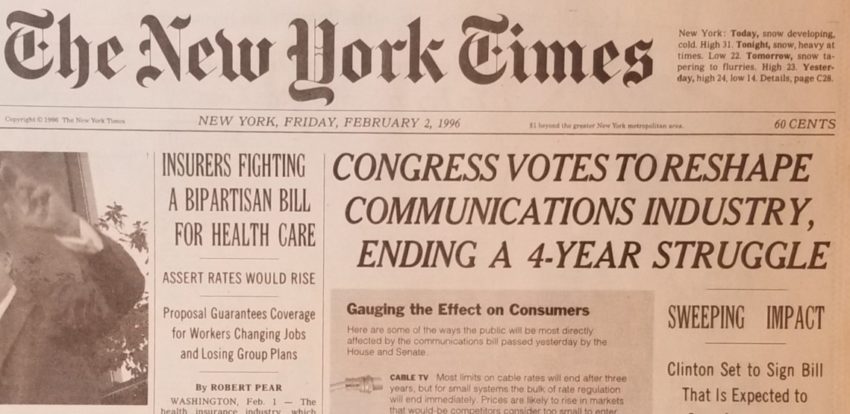Twenty-six years ago, President Bill Clinton signed the “Telecommunications Act of 1996”, a landmark overhaul of telecommunications law that completely changed the landscape of broadcasting in the United States. Billed as a way to allow any business to compete in the communications sphere, some of the most damaging provisions instead drove many small broadcasters out of the market, while allowing large corporations to scoop up broadcast licenses and reduce the number of independent voices in communities across the country.
Contrary to the stated intentions of allowing more businesses to operate in the communications space, the actual result of the Act was a flurry of mergers and acquisitions as corporate media giants bought out small, local broadcasters. This occurred because previously, there were strict limits to how many broadcast stations (both TV and radio) a single entity could own. There were also rules about cross-ownership, i.e. owning a radio station and a TV station in the same market. Within five years of the Act, radio station ownership dropped from 5100 owners to 3800. This trend has continued to the present, with corporate behemoth IHeartMedia (formerly Clear Channel) owning over 800+ stations across the country. In both radio and TV, consolidation occurred at a pace never before seen, massively reducing the number of independent broadcasters in communities across the United States.
This has a couple of negative effects. First, these stations are now be programmed from the corporate offices, using focus groups and market researchers to create a singular sound that is then broadcast by stations across the country, destroying the local/regional influence that small, independent broadcasters brought to smaller towns and cities. Second, it severely harmed the career options for people breaking into the radio industry. Before 1996, a mid-size city might have between 10-20 radio stations with jobs for programmers, producers, on-air talent, etc. Afterwards, those same stations might now be owned by 3 or 4 corporations, who stretch resources across multiple stations (or more often than not, just pull content from the corporate office via satellite). The effect was alarmingly swift: within a few years, cities what once had 100 jobs for radio professionals now had maybe 20.
This might be the biggest reason that college radio is still a vital and necessary part of the radio landscape. In many markets, college radio stations are the only non-religious radio broadcast that originates and is programmed locally. Independent voices are becoming exceedingly rare, and it is critically important that we don’t lose the few we have left.

